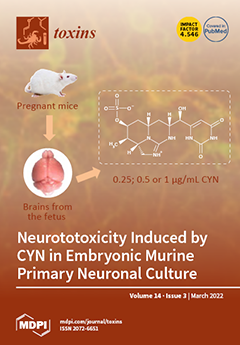To date, few studies have been carried out aimed at characterizing the toxins synthesized by hydrocorals of the genus
Millepora. The purpose of this study was to explore the toxin diversity and antibacterial activity of the “fire coral”
M. complanata using a
[...] Read more.
To date, few studies have been carried out aimed at characterizing the toxins synthesized by hydrocorals of the genus
Millepora. The purpose of this study was to explore the toxin diversity and antibacterial activity of the “fire coral”
M. complanata using a transcriptomic data mining approach. In addition, the cytolytic and antibacterial activities of the
M. complanata nematocyst proteome were experimentally confirmed. Cytolysins were predicted from the transcriptome by comparing against the Animal Toxin Annotation Project database, resulting in 190 putative toxins, including metalloproteases, hemostasis-impairing toxins, phospholipases, among others. The
M. complanata nematocyst proteome was analyzed by 1D and 2D electrophoresis and zymography. The zymograms showed different zones of cytolytic activity: two zones of hemolysis at ~25 and ~205 kDa, two regions corresponding to phospholipase A2 (PLA2) activity around 6 and 25 kDa, and a proteolytic zone was observed between 50 and 205 kDa. The hemolytic activity of the proteome was inhibited in the presence of PLA2 and proteases inhibitors, suggesting that PLA2s, trypsin, chymotrypsin, serine-proteases, and matrix metalloproteases are responsible for the hemolysis. On the other hand, antimicrobial peptide sequences were retrieved from their transcripts with the amPEPpy software. This analysis revealed the presence of homologs to SK84, cgUbiquitin, Ubiquicidin, TroTbeta4, SPINK9-v1, and Histone-related antimicrobials in the transcriptome of this cnidarian. Finally, by employing disk diffusion and microdilution assays, we found that the nematocyst peptidome of
M. complanata showed inhibitory activity against both Gram-positive and Gram-negative bacteria including
S. enteritidis,
P. perfectomarina,
E. coli, and
C. xerosis, among others. This is the first transcriptomic data mining analysis to explore the diversity of the toxins synthesized by an organism of the genus
Millepora. Undoubtedly, this work provides information that will broaden our general understanding of the structural richness of cnidarian toxins.
Full article






